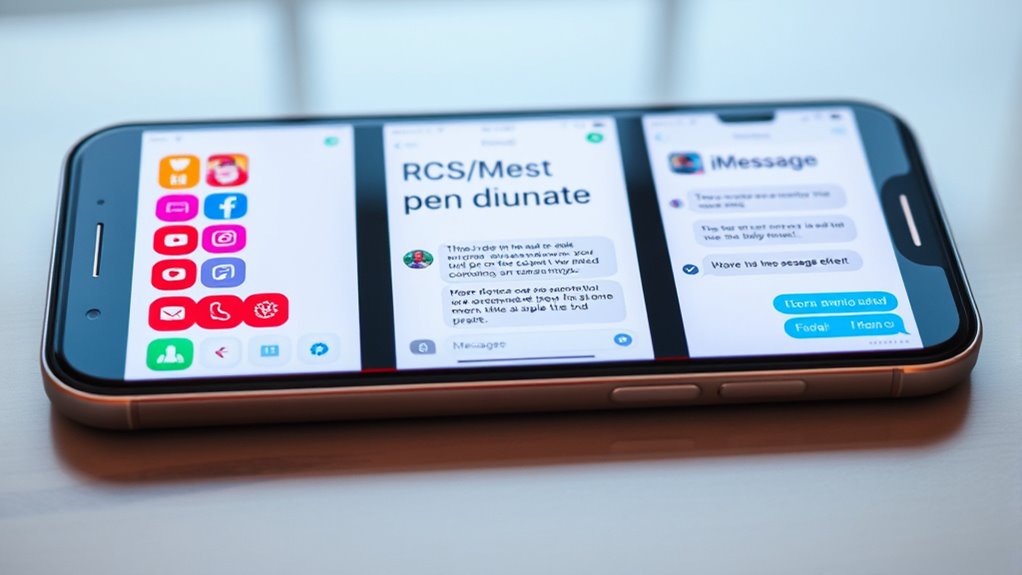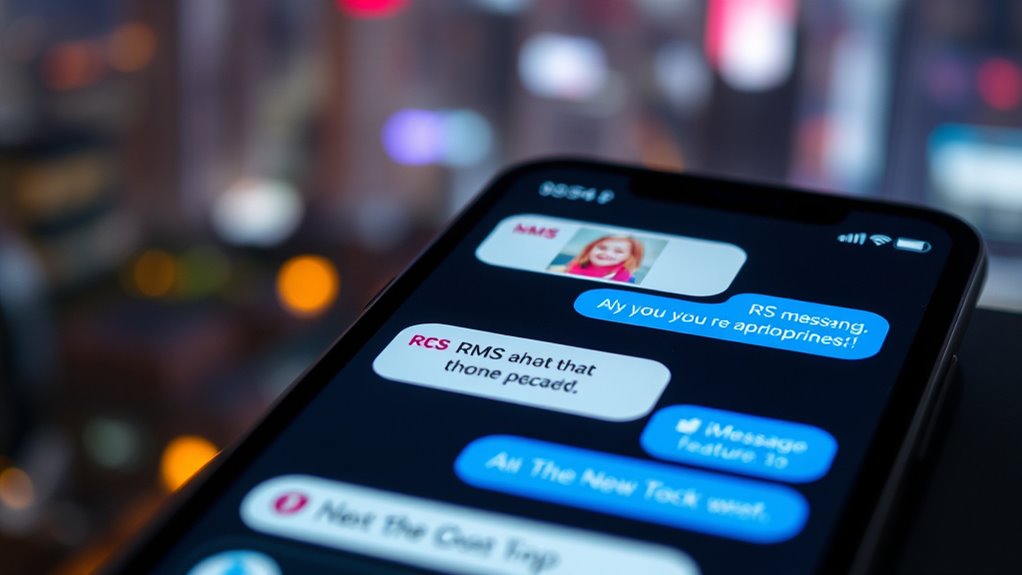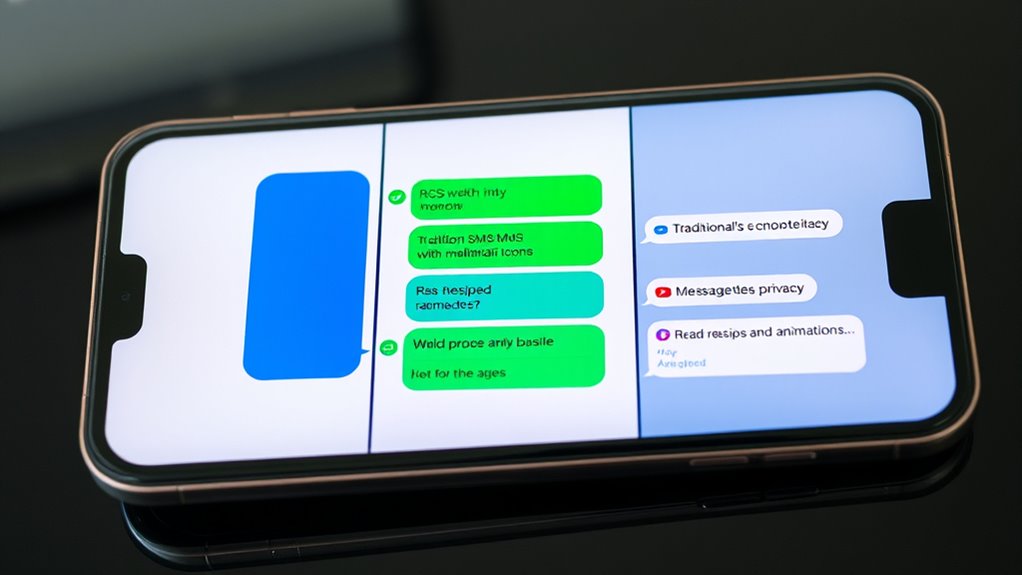RCS, SMS/MMS, and iMessage all offer different messaging experiences. SMS/MMS works on all phones but is limited in features and security. RCS adds richer media, group chats, and read receipts but faces compatibility issues, especially outside Android. iMessage provides advanced privacy, reactions, and app integrations but only for Apple users. Understanding these differences helps you choose the best protocol for your needs—if you want to explore further, there’s more to uncover.
Key Takeaways
- RCS offers richer multimedia, read receipts, and typing indicators over internet, while SMS/MMS provides basic text and media without encryption.
- iMessage provides end-to-end encryption and advanced features like reactions and app integrations, unlike RCS and SMS/MMS.
- SMS/MMS is universally supported but lacks encryption, making it less secure; RCS encrypts messages in transit, while iMessage encrypts end-to-end.
- RCS is expanding on Android devices, but limited support on iOS; iMessage is exclusive to Apple ecosystem, leading to cross-platform compatibility challenges.
- Future trends aim for unified messaging with enhanced privacy, reducing reliance on basic SMS/MMS and bridging gaps between Android and iOS users.
Overview of Messaging Protocols

Messaging protocols define how your messages are sent, received, and managed across different devices and networks. SMS/MMS uses cellular networks, with SMS limited to 160 characters and MMS supporting multimedia but with limited media quality. RCS, developed by GSMA, upgrades SMS/MMS by operating over internet connections like Wi-Fi or cellular data, supporting richer media, read receipts, and interactive features. Apple’s iMessage relies on internet connections, offering advanced features exclusive to Apple devices, such as message reactions and app integrations. While SMS/MMS is universally supported across all mobile devices, RCS mainly serves Android devices and is gradually expanding to iOS. Each protocol varies in capabilities, security, and device compatibility, shaping how you communicate across different platforms and networks.
Device and Platform Compatibility

Device and platform support heavily influences how you experience different messaging protocols. SMS/MMS works across all mobile phones, regardless of brand or operating system, making it the universal fallback. RCS primarily supports Android devices, with most major manufacturers and carriers adopting it, but iOS support is limited and evolving since iOS 18. iMessage is exclusive to Apple devices like iPhones, iPads, and Macs, offering seamless integration within Apple’s ecosystem. Cross-platform messaging is improving as Apple adopts RCS, but compatibility issues still occur when communicating between Android and iOS users. When devices or carriers don’t support RCS or iMessage, messages fall back to SMS/MMS, reducing features and experience quality. Your messaging experience depends heavily on your device and the platforms your contacts use. Additionally, understanding how protocols operate across different devices can help you optimize your messaging experience. Compatibility challenges can also impact security and privacy features, influencing your overall safety during communication. Differences in encryption methods between protocols can affect message confidentiality across platforms. Moreover, device support for these protocols varies widely, which can influence your ability to utilize advanced messaging features.
Privacy and Security Measures

You should know that iMessage provides end-to-end encryption by default, keeping your messages private from interception. RCS messages are encrypted during transit, but this protection isn’t universal and varies by carrier and device. Meanwhile, SMS and MMS lack encryption altogether, making them far less secure for sensitive conversations. AI security vulnerabilities highlight the importance of robust privacy measures in messaging protocols. Additionally, the level of security depends heavily on the implementation of encryption standards across different platforms and carriers. Furthermore, the presence of security vulnerabilities in some messaging protocols underscores the need for ongoing security updates and user awareness. Implementing encryption practices consistently across messaging services is crucial to enhance security. Incorporating security best practices can significantly reduce the risk of data breaches and unauthorized access.
End-to-End Encryption Status
While end-to-end encryption (E2EE) is a key feature for ensuring message privacy, its implementation varies markedly across different messaging protocols. iMessage offers robust E2EE by default, meaning only you and the recipient can read the message content, with no intermediaries able to access it. RCS messages are encrypted in transit, but universal E2EE isn’t yet standard; security depends on carriers and device manufacturers. This means your RCS chats are generally more secure than SMS or MMS, which lack encryption entirely and are vulnerable to interception. However, RCS’s partial encryption means it’s less private than iMessage. Overall, if privacy is your top priority, iMessage provides the strongest E2EE, while RCS offers improved security over traditional SMS/MMS but falls short of full encryption.
Network Encryption Differences
Network encryption methods differ markedly across messaging protocols, directly impacting your privacy and security. With iMessage, your messages are end-to-end encrypted, meaning only you and the recipient can read them. RCS encrypts messages in transit but doesn’t universally provide end-to-end encryption, making it more vulnerable. SMS and MMS lack encryption altogether, exposing your messages to interception. Easy to clean and maintain, ensuring prolonged message security and device lifespan. Additionally, the encryption standards used by each protocol influence their overall security effectiveness. iMessage: End-to-end encryption ensures message privacy. RCS: Encryption in transit, but not always end-to-end, varies by provider. SMS/MMS: No encryption, high vulnerability. Implication: Your privacy depends heavily on the protocol used and its encryption standards, with iMessage providing the most secure option. To better understand these differences, it’s important to consider the encryption protocols employed by each messaging system. Furthermore, advancements in encryption technology continue to enhance messaging security across different platforms.
Core Features and Functionalities

Your messaging experience hinges on media sharing and interactive features. While SMS and MMS are limited, RCS and iMessage offer advanced multimedia and engaging interactions. These core functionalities shape how seamlessly you communicate across platforms and devices. Additionally, incorporating privacy management options ensures user trust and compliance with regulations. For example, regional legal resources highlight the importance of understanding local laws that can influence messaging privacy and security policies. Recognizing the enhanced features of modern messaging protocols can further improve user engagement and satisfaction. For instance, unique and wicked planters exemplify the importance of creative and customizable options that elevate user engagement beyond basic messaging. Moreover, understanding messaging protocol compatibility helps ensure smooth communication across different devices and operating systems.
Media Sharing Capabilities
Media sharing capabilities vary markedly across messaging protocols, shaping how you send images, videos, and other multimedia content. With SMS/MMS, you’re limited to low-resolution images and short videos, often with size restrictions. RCS improves this by supporting high-resolution media, large file transfers, and even interactive media. Additionally, RCS is designed to be interoperable across carriers, enhancing compatibility and user experience. RCS also supports features like read receipts and the ability to see when others are typing, which are standard in modern messaging platforms. Furthermore, RCS’s compatibility with different devices ensures a seamless experience across smartphones and tablets. This protocol also emphasizes the importance of trust-building activities, which can enhance user confidence and satisfaction with media exchanges. The protocol’s encryption methods aim to improve privacy during media sharing, although full end-to-end encryption is still limited compared to other platforms. MMS offers basic multimedia support with quality limitations. RCS enables high-res media, group sharing, and read receipts. iMessage supports extensive multimedia, reactions, and app integrations. Fall back to SMS reduces media quality and features considerably.
Interactive Messaging Features
Interactive messaging features have become a key aspect of modern communication, allowing you to do more than just send plain text. With RCS, you can enjoy read receipts, typing indicators, and group chats that make conversations more dynamic. You can also share your location or send quick reply buttons to streamline responses. iMessage offers similar features like message reactions, message effects, and app integrations such as Apple Pay or FaceTime links, creating a richer experience. Meanwhile, SMS/MMS falls short, offering only basic text and multimedia without interactive elements. These core features enhance engagement, reduce misunderstandings, and make messaging more efficient. Whether you’re sharing a location or reacting to a message, these interactive elements transform simple exchanges into versatile, engaging conversations. Additionally, understanding the interactive messaging features that are transforming communication can deepen your appreciation for storytelling techniques used in modern media.
User Experience and Adoption Trends

The adoption of RCS and iMessage has considerably shifted user experiences, with each platform catering to different audiences and ecosystems. You’ll find RCS gaining ground on Android, with over a billion users, especially as carrier support expands and Apple begins integrating RCS into iOS 18. Meanwhile, iMessage remains dominant within Apple’s ecosystem, with more than 2 billion users enjoying seamless, feature-rich messaging. However, cross-platform messaging can be inconsistent, especially when participating with users on unsupported carriers or devices.
- RCS’s growth depends on carrier and device support
- iMessage’s exclusivity keeps users within Apple’s ecosystem
- Mixed-platform chats often fallback to basic SMS/MMS
- Future trends point toward unified, richer messaging experiences
Challenges and Limitations

Despite the promise of richer features, RCS faces significant hurdles that hinder widespread adoption and seamless functionality. One major challenge is inconsistent implementation across carriers and devices, leading to fragmented user experiences. Compatibility issues arise, especially with iOS devices, where RCS support is limited and often relies on partial integration. Security remains a concern; while messages are encrypted in transit, end-to-end encryption isn’t yet universal, leaving sensitive data vulnerable. Additionally, RCS depends on cellular and internet connectivity, so messages can fail or revert to basic SMS when networks are unreliable. User adoption is hampered by the dominance of SMS and the closed nature of iMessage, making it difficult to create a truly unified messaging ecosystem. These limitations slow RCS’s potential to replace traditional texting fully.
Future Developments and Market Impact

Emerging developments in messaging technology are shaping a more unified communication landscape, with Apple’s integration of RCS support in iOS 18 playing a pivotal role. This shift could reduce the dominance of iMessage’s closed ecosystem and promote cross-platform compatibility. RCS’s expansion aims to replace SMS as the default on Android and, increasingly, on iOS, bringing richer multimedia and interactive features worldwide. However, carrier-dependent implementations and inconsistent encryption still challenge widespread adoption. As RCS and iMessage grow closer, expect a gradual decline in reliance on basic SMS/MMS. This evolution may improve user experience, promote privacy, and foster competition among messaging protocols.
- RCS’s broader adoption depends on carrier support and encryption improvements
- Cross-platform messaging becomes more seamless, reducing ecosystem silos
- Enhanced features could shift user preferences toward richer communication
- Market dynamics may favor unified standards over legacy protocols
Choosing the Right Messaging Solution

Choosing the right messaging solution depends on your device ecosystem, privacy needs, and communication priorities. If you use Apple devices, iMessage offers the best experience with end-to-end encryption, rich media, and seamless syncing. For Android users, RCS is a good upgrade from SMS, providing multimedia, read receipts, and group chats—though security varies. If you need universal support across different brands and carriers, SMS/MMS remains reliable but limited in features and security. Consider your privacy concerns: iMessage provides the strongest encryption, while RCS and SMS are less secure. Your choice should balance device compatibility, security, and the features you value most. If cross-platform communication is essential, RCS’s expanding support and Apple’s recent integration efforts make it a promising option.
Frequently Asked Questions
How Does Message Delivery Differ When Switching Between Protocols?
When switching protocols, your message delivery can change substantially. If you send an SMS, it’s quick but limited to text and may not support media or read receipts. Using RCS, your messages can include high-res media, typing indicators, and group chats, but delivery depends on carrier support. With iMessage, your messages are encrypted, support rich media, and sync across Apple devices, ensuring a seamless experience within the Apple ecosystem.
Can RCS and Imessage Communicate Directly Without Fallback?
Currently, RCS and iMessage can’t communicate directly without fallback. RCS primarily works with Android devices and supports internet messaging, while iMessage is exclusive to Apple devices. They use different protocols, so messages between them typically fall back to SMS/MMS unless Apple fully adopts RCS standards for cross-platform support. Until Apple or carriers enable direct interoperability, you’ll need to rely on fallbacks or third-party apps for cross-platform messaging.
What Are the Costs Associated With Using Each Messaging Protocol?
Are you aware of the costs involved? Using SMS/MMS usually incurs per-message charges from your carrier, especially for multimedia or international texts. RCS typically costs nothing extra beyond your data plan but depends on carrier support. iMessage is free over Wi-Fi or cellular data but may rack up data charges if you’re not on unlimited plans. Could paying less for messaging mean sacrificing features or privacy?
How Does Cross-Platform Group Chat Functionality Vary Across Protocols?
Cross-platform group chat functionality varies substantially across protocols. With SMS/MMS, group chats are limited and often unreliable, sometimes converting to individual messages. RCS offers more advanced features like group chats with read receipts and multimedia sharing, but support depends on carriers and devices. iMessage provides seamless, feature-rich group chats within the Apple ecosystem, including reactions and pinning, but struggles with cross-platform compatibility, often falling back to SMS and losing advanced features.
Are There Any Privacy Risks Unique to Each Messaging System?
While each messaging system has unique privacy risks, they’re manageable if you understand them. With iMessage, your messages are end-to-end encrypted, making interception almost impossible. RCS encrypts messages in transit but isn’t fully secure, so carrier or device vulnerabilities exist. SMS and MMS lack encryption altogether, making them highly vulnerable to interception. You should be cautious about sharing sensitive info over non-encrypted platforms and stay updated on encryption improvements.
Conclusion
Choosing the right messaging solution depends on your priorities. For instance, a business might favor RCS for richer features and broader compatibility, while a family may stick with iMessage for privacy and seamless integration. Imagine a small startup adopting RCS to streamline customer interactions—balancing security, features, and device compatibility. Ultimately, understanding each protocol’s strengths helps you select the best fit, ensuring your messaging stays efficient, secure, and tailored to your needs.









